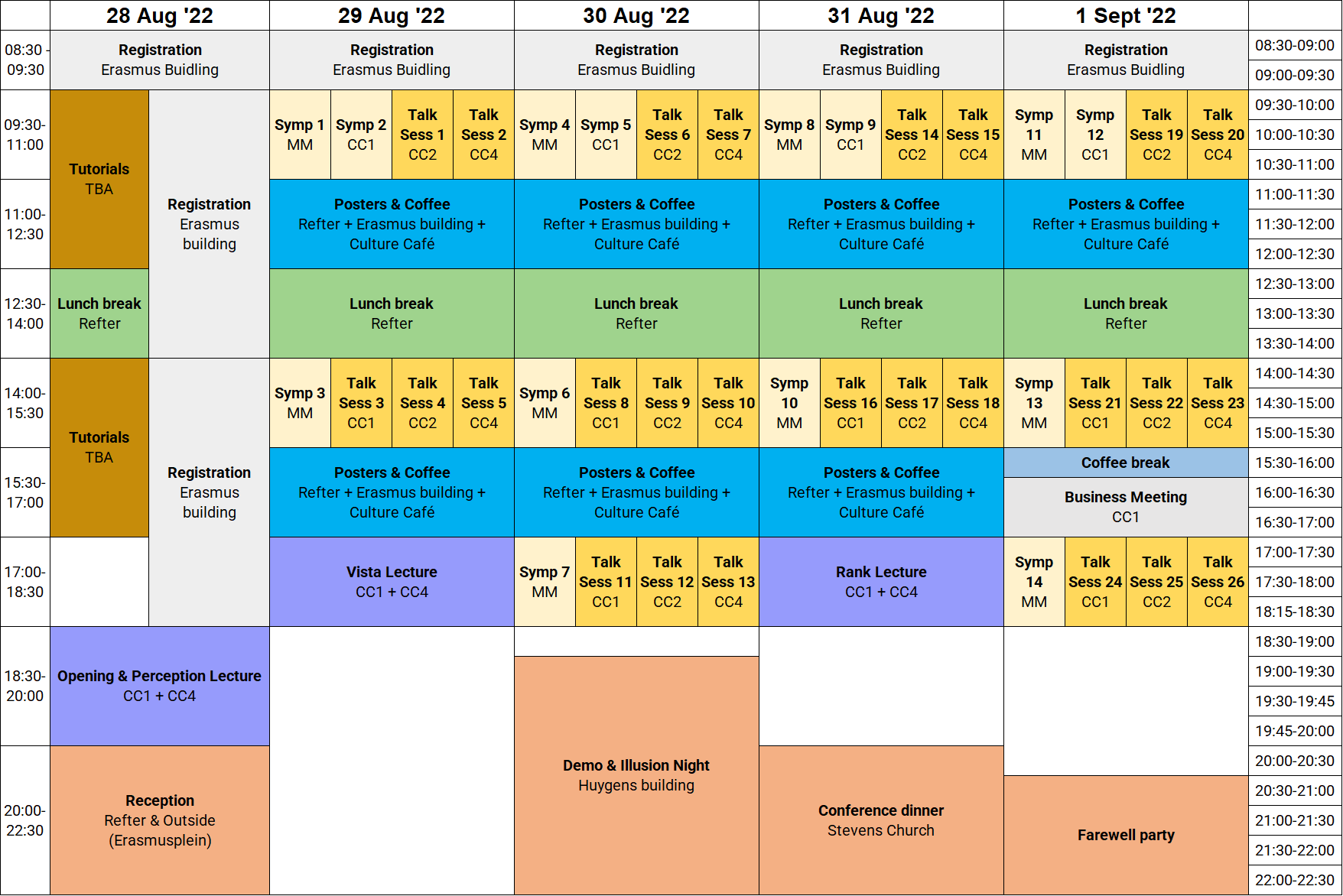Program
As in previous years, the 2022 edition of the ECVP will contain a wide variety of interesting keynote lectures, tutorials, symposia, poster sessions, a demo night and more.
CLICK HERE TO DOWNLOAD THE DETAILED PROGRAM
Please note that the poster locations and numbers, will be made known at a later time. More specifically, detailed information, including the abstracts, will be made available via a conference app.
Keynote lectures
(click here for more information)
- Opening & Perception Lecture: Professor Johan Wagemans (KU Leuven)
- Vista Lecture: Professor Marcel van Gerven (Radboud University)
- Rank Lecture: Professor Zoe Kourtzi (University of Cambridge)
Symposia
A symposium provides a diverse overview of a lively research area that is of interest for the ECVP audience. Symposium organizers were asked to include speakers from different groups, who represent a broad range of views and ideas under the umbrella of the symposium topic. The individual talks relate to each other and should be suited to provoke discussion. All symposia have a total length of 1,5 hours. The time is shared among 4-6 speakers, who each contribute with a talk of 15 or 30 min, including discussion. The symposium will be moderated by the organizer or a selected speaker. The ECVP organizers explicitly also encouraged young investigators to take the chance of organizing a symposium.
List of symposia (click here for full description):
- Computational perspectives on perceptual confidence (Laura Geurts & Janneke Jehee)
- Visual expertise: real-life applications and underlying mechanisms (Meike Ramon, Mauro Manassi)
- Large-scale spatial vision (Peter Neri, Michael Herzog)
- Cortical Circuitry Mapping using Connective Field Modelling (CFM) in perception and ophthalmic and neurologic disease (Frans Cornelissen)
- Perception and (inter)actions in the real world and XR: Virtually the same or really different? (Constanze Hesse, Martin Giesel)
- ToddFest: Perception of 3D Shape, Space, and Materials Celebrating 43 Years of Jim Todd (William Warren, Ennio Mingolla, Jan Koenderink)
- Multistable perception: when and how bottom-up and top-down interact? (Alexander Pastukhov, Jürgen Kornmeier)
- From vision to attention: the development of visual perception in early childhood (Joanna Rutkowska, Sabine Hunnius)
- Advantages of virtual reality developments for perception research (Szonya Durant)
- Population Receptive Field Modelling: Recent advances and applications (Ben Harvey)
- Eyeballing the visual field: eye-tracking- and pupillometry-based alternatives for visual field assessment (Minke de Boer, Anne Vrijling)
- What do inter-item biases in perception and visual working memory tell about vision? (Andrey Chetverikov, David Pascucci)
- Individual differences in mental imagery and anomalous perception (Reshanne Reeder, Tessa M. van Leeuwen)
- Inhibition of Return and Visual Search (Raymond M. Klein)
Talk sessions
| Monday | Tuesday | Wednesday | Thursday |
|---|---|---|---|
|
|
|
|
Poster sessions
| Monday | Tuesday | Wednesday | Thursday |
|---|---|---|---|
|
|
|
|
Tutorials
- Visual Neuroscience meets Machine Learning (Tim Kietzmann, Kate Storrs, Adrien Doerig, Gemma Roig, Umut Guclu)
- Eye movements recording, analysis, and modeling (Olga Shurygina & Nicolas Roth)
- Spatiotemporal signals in vision models: diving in with Jupyter Notebook (Lynn Schmittwilken, Joris Vincent)
- Encoding and decoding models in neuroimaging (Janneke Jehee, Iris Groen, Serge Dumoulin, Ilona Bloem).
- Neuromodulation using Transcranial Ultrasound Stimulation (Lennart Verhagen)
- Theory and practice of Bayesian inference using JASP (Johnny van Doorn)
Illusion and Demo Night
On Tuesday August 30th, from approximately 18:45 onwards, the ECVP will host the Illusion & Demo Night: An interactive evening open to the general public. The Illusion & Demo Night will take place on campus at the Huygens building, Heyendaalseweg 135, Nijmegen. 📍
Conference dinner
The conference dinner on August 31 will be served in the Stevenskerk, Sint Stevenskerkhof 62, Nijmegen 📍. The Stevenskerk is the oldest and biggest church of Nijmegen, build in the late gothic style. It is situated on top of a small hill, the Hundisburg, in the heart of the city center.
Farewell party
The farewell party on September 1 will be in De Vereeniging, Keizer Karelplein 2d, 6511 NC, Nijmegen 📍. Come dance the night/conference away with DJ Stefan van der Stigchel! De Vereeniging is one of the largest stages in Nijmegen in the heart of the city. It is located at the famous Keizer Karelplein, in the city centre.
